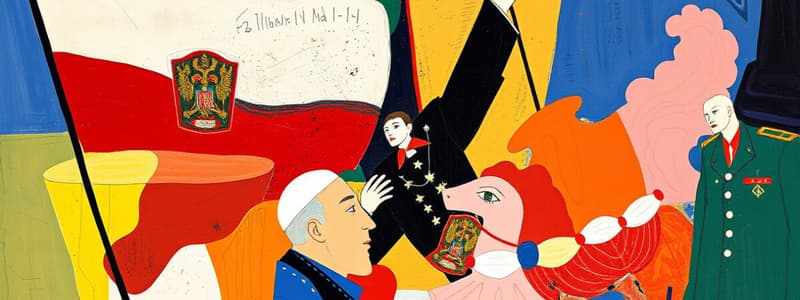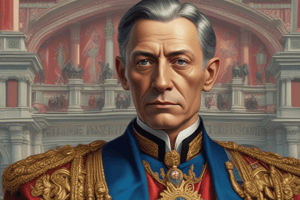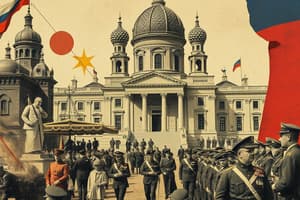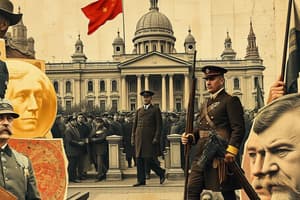Podcast
Questions and Answers
What were the main characteristics of the Provisional Government?
What were the main characteristics of the Provisional Government?
- It was elected and fully represented the Russian populace.
- It effectively addressed major issues such as land and war.
- It established a completely new political framework for Russia.
- It was unelected and largely viewed as a continuation of the old regime. (correct)
What was the intended purpose of the Provisional Government?
What was the intended purpose of the Provisional Government?
- To enact immediate reforms in the peasant land distribution.
- To strengthen the authority of Nicholas II.
- To serve as a temporary arrangement until the election of a Constituent Assembly. (correct)
- To permanently change the autocratic system in Russia.
What was Kerensky's intention behind his final actions as part of the Provisional Government?
What was Kerensky's intention behind his final actions as part of the Provisional Government?
- To eliminate the influence of the Soviets in local elections
- To strengthen the governance of Russia until the Constituent Assembly elections (correct)
- To dissolve the Provisional Government and bring about immediate elections
- To ensure military support for the Bolsheviks
How did the Provisional Government handle domestic policies?
How did the Provisional Government handle domestic policies?
What was the political context in Russia prior to World War One?
What was the political context in Russia prior to World War One?
What factor contributed significantly to the decline of support for the Provisional Government during its rule?
What factor contributed significantly to the decline of support for the Provisional Government during its rule?
Which event was a result of the Provisional Government's weakened position?
Which event was a result of the Provisional Government's weakened position?
What event primarily contributed to the power vacuum in Petrograd in 1916?
What event primarily contributed to the power vacuum in Petrograd in 1916?
What did Trotsky's restored leadership in the Petrograd Soviet indicate about the political landscape?
What did Trotsky's restored leadership in the Petrograd Soviet indicate about the political landscape?
How did war contribute to the instability of the Russian political system?
How did war contribute to the instability of the Russian political system?
What was one of the major weaknesses of the Provisional Government during its time in power?
What was one of the major weaknesses of the Provisional Government during its time in power?
Which phrase best describes the relationship between the Provisional Government and the Petrograd Soviet?
Which phrase best describes the relationship between the Provisional Government and the Petrograd Soviet?
What was a significant outcome of the societal conditions leading up to World War One in Russia?
What was a significant outcome of the societal conditions leading up to World War One in Russia?
What was a significant outcome of the February Revolution in 1917?
What was a significant outcome of the February Revolution in 1917?
Which political groups primarily made up the first version of the Provisional Government?
Which political groups primarily made up the first version of the Provisional Government?
What issue ultimately led to the end of the first Provisional Government?
What issue ultimately led to the end of the first Provisional Government?
What was the primary agreement reached in the first coalition between the Provisional Government and the Petrograd Soviet?
What was the primary agreement reached in the first coalition between the Provisional Government and the Petrograd Soviet?
Who was predominantly responsible for the launch of the June Offensive?
Who was predominantly responsible for the launch of the June Offensive?
What characterized the Second Coalition of the Provisional Government?
What characterized the Second Coalition of the Provisional Government?
What action did Kerensky take during the Kornilov Affair?
What action did Kerensky take during the Kornilov Affair?
What was the primary goal of the Third Coalition of the Provisional Government?
What was the primary goal of the Third Coalition of the Provisional Government?
Which group ultimately gained dominance shortly before the collapse of the Provisional Government?
Which group ultimately gained dominance shortly before the collapse of the Provisional Government?
The Petrograd Soviet's Order Number 1 had what effect on the Provisional Government's authority?
The Petrograd Soviet's Order Number 1 had what effect on the Provisional Government's authority?
What was the reaction within Russia towards the continuation of the war by the Provisional Government?
What was the reaction within Russia towards the continuation of the war by the Provisional Government?
What did the failure of the June Offensive lead to in terms of government leadership?
What did the failure of the June Offensive lead to in terms of government leadership?
What event marked a turning point indicating the decline of support for the Provisional Government?
What event marked a turning point indicating the decline of support for the Provisional Government?
How did the Provisional Government aim to reestablish order in Russia?
How did the Provisional Government aim to reestablish order in Russia?
Flashcards are hidden until you start studying
Study Notes
Nature of the Provisional Government
- Formed during a chaotic period in Russian history as a temporary solution until a Constituent Assembly could be elected.
- Characterized by being unelected, unrepresentative, and a continuation of the ‘old guard’ from the Tsarist regime.
- Collaboration with the Petrograd Soviet created both advantages and challenges throughout its existence.
- Domestic policies offered some revolutionary freedoms but failed to address critical issues like the war and land reform.
Political Context Before World War I
- Russia was an autocracy under Tsar Nicholas II, with limited democratic structures.
- The Duma had a conservative bias due to manipulative electoral changes after the second Duma in 1907.
- By 1914, the Fourth Duma was largely ineffective in opposing Tsarist authority amidst social unrest from events like the Lena Goldfields strike.
- The government under Tsar Nicholas II maintained control through repression following the 1905 Revolution.
Impact of World War I
- The war worsened existing social and governmental issues, creating a power vacuum as Nicholas II commanded the military, leaving Tsarina Alexandra in control.
- This vacuum saw the rise of the Petrograd Soviet and the Provisional Committee.
- By 1917, public sentiment had shifted dramatically, with a strong desire for change.
Composition and Structure of the Provisional Government
- Unique dual authority system, sharing power with the Petrograd Soviet, unlike previous Tsarist or Communist governments.
- Initially consisted of conservative elements (Kadets, Octobrists) with some socialist representation through figures like Kerensky.
First Version of the Provisional Government (March-April 1917)
- Established foundational principles aiming towards a liberal state and garnered support from the Petrograd Soviet initially.
- Authority undermined by Soviet Order Number 1, which limited its power over military forces.
- The decision to continue the war led to public outrage and government resignations, culminating in its disbandment.
First Coalition (May-June 1917)
- In response to turmoil, a coalition with the Petrograd Soviet was formed, focusing on peace negotiations and labor policies.
- The June Offensive, led by Kerensky, marked a turning point, revealing internal discord and resulting in distrust among government members.
- The failure of the offensive contributed to instability and a shift towards more socialist governance.
Second Coalition (June-September 1917)
- Marked by significant events like the July Days and the Kornilov Affair, which tested the Provisional Government's authority.
- Kerensky used military force to maintain control, indicating his willingness to take extreme measures against opposition.
- The aftermath of the Kornilov Affair weakened the Provisional Government’s support and revealed its vulnerability.
Third Coalition (September-October 1917)
- Comprised of both Kadet and socialist members focused on governance until a Constituent Assembly could convene.
- Organized the All Russian Democratic Conference to lay groundwork for future elections, although many viewed these efforts as inadequate.
- Ongoing struggles with the Bolsheviks’ increasing influence undermined confidence in the Provisional Government, leading to further decline.
Overall Challenges and Failures
- The Provisional Government was characterized by inconsistency, reliance on Soviet support, and inability to manage critical issues effectively.
- Key weaknesses included continuous personnel changes, ongoing war engagement, and loss of popular support, ultimately leading to its failure.
Studying That Suits You
Use AI to generate personalized quizzes and flashcards to suit your learning preferences.




